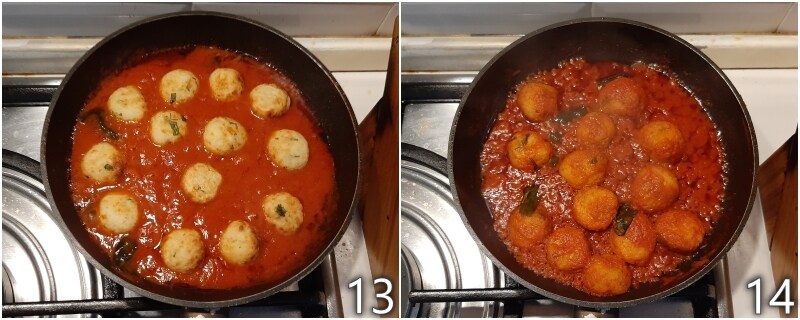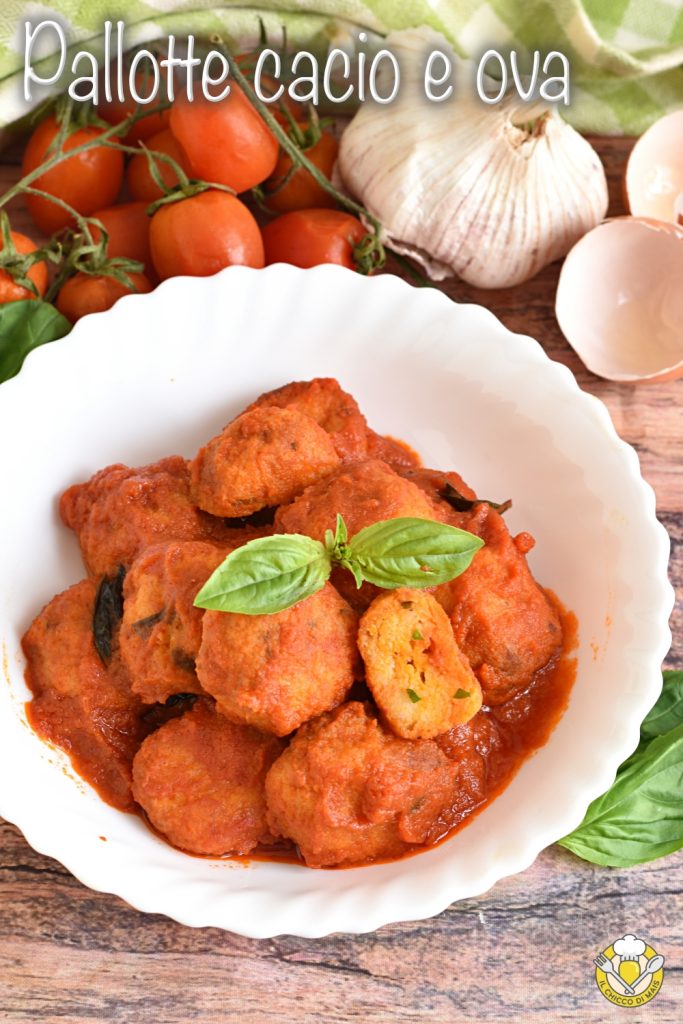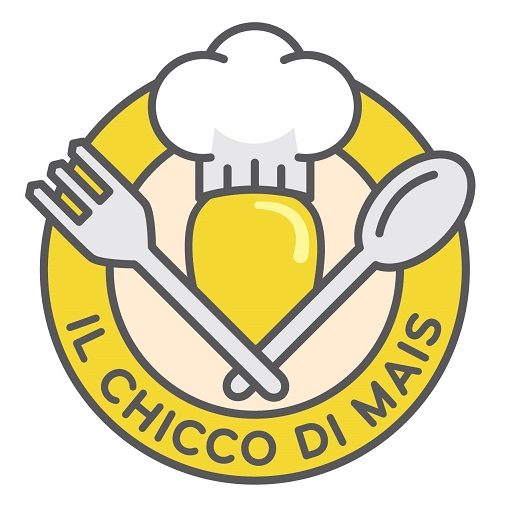The cheese and egg balls (or pallotte cac’e ove in Abruzzo dialect) are one of the most iconic recipes of Abruzzo’s culinary tradition, appreciated beyond the region for their rustic, genuine, and irresistible flavor. Like many peasant dishes, they originate as a recovery dish: the main ingredient is stale bread, which is enhanced and transformed into a real delicacy. The bread crumb is kneaded with eggs and Abruzzo pecorino cheese – traditionally Rigatino, typical of the area – until a soft yet firm mixture is obtained. From this, meatballs a little larger than a walnut are made, first fried in hot oil for a golden crust, then immersed in a simple tomato sauce with basil, where they flavor and soften. The cheese and egg balls can be served as either an appetizer or a vegetarian main course. In both cases, it is highly recommended to accompany them with good bread, because the bread dipping is not only inevitable but practically a ritual!
You might also be interested in:

- Difficulty: Easy
- Cost: Very Cheap
- Preparation time: 20 Minutes
- Portions: 4People
- Cooking methods: Stove, Frying
- Cuisine: Regional Italian
- Region: Abruzzo
- Seasonality: All seasons
- Energy 446.15 (Kcal)
- Carbohydrates 35.81 (g) of which sugars 1.55 (g)
- Proteins 18.33 (g)
- Fat 27.33 (g) of which saturated 2.90 (g)of which unsaturated 3.57 (g)
- Fibers 3.98 (g)
- Sodium 940.46 (mg)
Indicative values for a portion of 187 g processed in an automated way starting from the nutritional information available on the CREA* and FoodData Central** databases. It is not food and / or nutritional advice.
* CREATES Food and Nutrition Research Center: https://www.crea.gov.it/alimenti-e-nutrizione https://www.alimentinutrizione.it ** U.S. Department of Agriculture, Agricultural Research Service. FoodData Central, 2019. https://fdc.nal.usda.gov
Ingredients for Cheese and Egg Balls
To prepare gluten-free balls, I recommend using fresh gluten-free bread rather than a packaged product, as the crumb needs to absorb the liquids well. I used homemade bread with this recipe.
- 5.3 oz stale bread (crumb only; for me gluten-free)
- 2 eggs (medium)
- 5.3 oz Abruzzo pecorino
- 1 bunch parsley (optional)
- 1 clove garlic (optional)
- as needed milk
- as needed peanut oil
- as needed pepper
- 24.7 oz tomato passata
- 1 clove garlic (or half an onion)
- A few leaves basil
- 4 tbsps extra virgin olive oil
- 1 pinch salt
Tools
- 2 Bowls
- 1 Pan
- 1 Skillet wide with lid
- Paper Towels
How to Prepare Cheese and Egg Balls from Abruzzo
To prepare cheese and egg balls, start by placing the stale bread crumb in a bowl or dish with some milk (1). Let it sit for 10-15 minutes, then squeeze to remove excess milk (2) and transfer it to a bowl. Add a dash of pepper and chopped parsley (optional) (3).

I don’t add salt to the mixture because the pecorino is already salty. Some recipes include adding a finely chopped or crushed garlic clove with a garlic press. Beat the eggs in a separate bowl and add them to the bread crumb; also add the grated pecorino (4). Mix everything with a spoon until you get a homogeneous and easily workable mixture (5). Form balls slightly larger than a walnut (6).

As you form the balls, place them on a cutting board (7). Some versions of the recipe suggest coating the balls in flour after forming them. I don’t find it necessary, but if you notice the balls are not holding their shape, you can do it. Heat abundant peanut oil in a pan and dip the balls into it (8). Let them cook for 2-3 minutes or until golden, then remove with a slotted spoon and place on paper towels to dry (9).

Meanwhile, prepare the tomato sauce: pour olive oil into a large skillet and add the garlic clove (10); if you prefer, you can use half a finely sliced onion instead. Let it gently fry, then add the tomato passata, a pinch of salt, and the torn basil (11). Cover with a lid and cook over low heat for 10 minutes (12).

After the cooking time, dip the cheese and egg balls in the sauce (13) and continue cooking over low heat for about 10 minutes with the lid on, turning the balls occasionally so they absorb the sauce well. Then turn off the heat (14).

Serve the cheese and egg balls hot, as an appetizer or vegetarian main course, accompanied by a good slice of bread to soak up the sauce.

Storage
You can store the cheese and egg balls in the fridge, sealed in a glass container, for 3 days.
Tips and Variations
As with many traditional recipes, there are slight variations in cheese and egg balls from area to area in Abruzzo and even from family to family. The parsley and garlic in the mixture, for example, are optional, and for the sauce, some use onion while others use garlic. The ratio of bread to pecorino can also vary significantly. I’m not from Abruzzo, but I’ve had the fortune to taste this dish often, and the version I propose seems to me to be among the most representative and widespread of the local tradition.
FAQ (Questions and Answers)
What can I use instead of Abruzzo pecorino?
The traditional recipe for the balls includes Rigatino, a pecorino that is not easy to find outside central Italy. You can substitute it with a mix of Pecorino Romano and Parmesan (for 5.3 oz of Rigatino, I recommend 3.2 oz of Pecorino Romano and 2.1 oz of Parmesan).
Can I avoid frying the balls?
Yes, the balls can be directly placed in the tomato sauce to avoid frying, but if the consistency isn’t perfect, they might fall apart. I prefer to fry them first or, at least, cook them in an air fryer at 338°F for 10 minutes.

